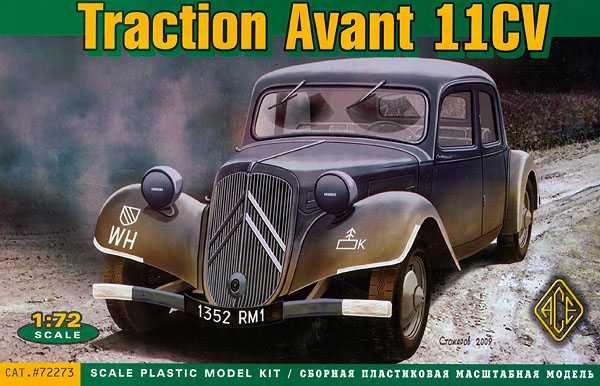
Ace 1/72 Citroën Traction Avant 11CV
By Chris Banyai-Riepl
Overview
In late 1933, two French designers, André Lefèbvre and Flaminio Bertoni created the Traction Avant (forward traction) car for Citroën. This marked the true beginning of front wheel drive cars (others came before, but this was the first really successful FWD car), and Citroën produced the Traction Avant for the next twenty-three years (minus a short break during the war). Around three quarters of a million vehicles were produced between 1934 and 1957, making it a very popular sight on the streets of Europe.
The vehicle was produced in three main variants, distinguished by the size of the engine. The 7CV had a 1.3-liter engine, the 11CV a 1.9-liter engine, and the 15CV a 2.9-liter engine. Different body styles included a two-door coupé and a four-door sedan, the latter offered in an enlarged variant with three rows of seats. Over the years, the body remained static in design, with only small detail changes marking the changing years.
Although innovative in many ways (in addition to the front wheel drive, the Traction Avant was also the first mainstream car to adopt unibody construction), the development costs forced the company into bankruptcy. Michelin, as the largest creditor, took over the company and kept it solvent by running it as more of a research laboratory than an automobile factory. This is most likely why the Traction Avant remained virtually unchanged throughout its history.
The Kit
The Traction Avant has seen an interesting jump in popularity, at least in model kits, with first the Tamiya 1/48 release and now the Ace 1/72 kit. In both cases they are marketed as Luftwaffe staff cars, but aside from slit headlights, these kits can be made up as civilian vehicles quite easily. The Ace kit is molded in a light gray plastic, spread through two sprues. A small decal sheet provides a handful of markings for four options. There are no clear parts, with those instead provided in the form of a template in the instructions, for the modeler to cut from clear stock.
Construction is straightforward. The one-piece chassis includes the floor of the interior, with separate seats. On the underside, there are various brackets, axles, the exhaust pipe, and the characteristic curved bumpers. No engine is included, other than a molded-in relief on the underside of the chassis. The headlights and taillights are separate, which is a good thing as that allows you to model a larger variety of Traction Avants (the 1938 variant introduced a single taillight, while the twin taillights were re-introduced in the late 1940s/early 1950s).
Moving on to the body, this is made up from four pieces: two sides and a top, and a separate front grill. The dashboard is separate, with the steering wheel fitting to that. There is no firewall provided, which means that looking through the rear window gives you a complete view straight up to the grill. It is highly recommended that a simple firewall be added from scrap plastic. Likewise, there are no pedals provided, and those too would be simple additions from scrap plastic (don't forget the clutch: it may have been front wheel drive, but it wasn't an automatic!).
For markings, there are three military and one civilian example included in the small decals sheet. This decal sheet is simple: it just has the license plates, both front and rear, for these four options. The civilian example is overall gloss black (a common color for the entire run of Traction Avants; don't worry, though, there are much more colorful options out there), while the two German examples are overall Panzer Gray and the French military example is overall olive green.
The key to finishing this little model (and little it is: just over an inch long!) is in the details, and it is here that careful research will really pay off. One of the best references I have come across for this vehicle is the Cats Citroën Net website. This website has a detailed history of the changes found in the 11CV production line, as well as a page documenting the color schemes worn by the car. For example, out of the box the kit represents an early 1938 11CV, which could be finished in a striking maroon, green, or blue, with black fenders. Backdating the car to a 1935 variant opens up even more options, with marine blue, gray blue, two shades of tan, and a pearl gray, again with black fenders. Definitely more colorful than panzer gray.
Conclusion
This is a great addition to the 1/72 scale range, whether for armor modeler, automotive modelers, or even aviation modelers. While many would think of the wartime staff car as a good option, I see this as a great set piece next to any number of early 1950s aircraft, with the pilot getting out of his classic Traction Avant before taking to the skies in his Vampire, Ouragan, or Thunderjet.
My thanks to Scale Model Kits for the review sample. Visit their website for this and other kits in the Ace product line.
